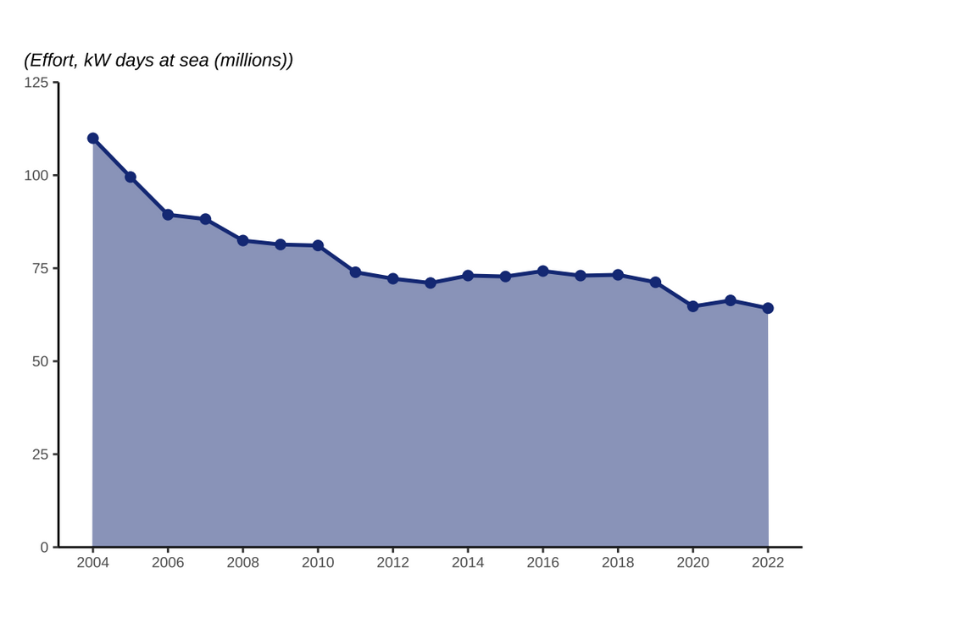Section 3 – Effort
Updated 19 December 2023
1. Key Statistics - Effort
Since 2004, fishing effort (kW days at sea) by the over 10m fleet has decreased by around 40%. Most of the reduction in effort is driven by a 41% decline in effort in the demersal trawl and seine segment.
Fishing effort by the over 10m fleet decreased by 3% between 2021 and 2022.
Western Waters
To prevent growth in fishing activity in the sea areas to the west of the UK, Ireland, Spain, Portugal and Morocco, an area (the ‘Western Waters’) was established from November 2003 in which fishing effort is limited.
Trips targeting edible crabs and spider crabs, demersal species and scallops are covered by the Western Water effort regime.
Following the end of transition from the EU in 2021 the UK has been enforcing the EU Western Waters regulation as amended by The Common Fisheries Policy (Amendment etc.) (EU Exit) Regulations 2019. The scope of this regulation has been changed to be consistent with the jurisdiction of the UK as an independent coastal state, and as such limits the application to those parts of the areas covered by Western Waters which are within United Kingdom waters.
Western waters effort statistics are also updated monthly here: https://www.gov.uk/government/collections/effort-use-statistics
These monthly statistics are provided to supervise control of fishing effort in Western Waters areas within British fisheries limits waters by UK vessels. The Western Waters regulations were originally derived from EU law and have been transposed into UK law. The statistics are made available on or after the 15th day of each month.
2. Over 10 metre fleet
2.1 Effort
Fishing effort captures the time vessels spend fishing. One measure of this is days at sea. Another measure is kW days at sea, which considers both the time vessels spend fishing and the power (kW) of the vessel’s engine.
Effort restrictions are one of the ways fish stocks are managed. Limiting the number of days vessels can fish restricts their fishing opportunities.
Figure 3.1: Fishing effort shown by kW days at sea (millions) from 2004 to 2022 by the over 10m fleet.

Since 2004, fishing effort (kW days at sea) by the over 10m fleet has decreased by around 42%.
Between 2004 and 2012 there was a fairly sharp decline, from 110 million kW days at sea down to around 72 million kW days at sea, but this then levelled off and remained relatively stable before seeing another decline down to around 65 million kW days from 2019 onwards.
Figure 3.2: Fishing effort shown by kW days at sea (millions) comparing 2007 to 2022 by the over 10m fleet by gear metier.

Effort by the demersal trawl and seine segment of the fleet fell by 41% between 2004 and 2022 to 32 million kW days at sea. The beam trawl segment, which has relatively lower levels of effort (5.9 million kW days at sea in 2022) fell by 67% over the same period.
This reduction in effort in the demersal trawl and seine segment followed decommissioning exercises which were carried out by UK fisheries administrations between 2001 and 2003. The latter focused on removing fleet capacity targeting cod in the Cod Recovery Zone (a combination of North Sea, West of Scotland and Irish Sea fishing areas) and was particularly focused on vessels that used demersal trawls for whitefish. A further exercise was carried out to remove excess beam trawl fishing capacity in the Western Channel fishing area as part of the recovery regime for sole. This removed eight vessels previously active in the area.
3. Sole Recovery Zone
3.1 Sole Recovery Zone (SRZ)
As part of the measures for recovery of sole stocks, a Sole Recovery Zone was established from 2004 to apply effort controls to vessels of 10 metres or over, using certain gears (including beam trawls) in the Western Channel. Further information of SRZ measures can be found here: https://www.gov.uk/government/publications/manage-your-fishing-effort-sole-recovery-zone/sole-recovery-zone-rules
The Marine Management Organisation controls effort in the Western Channel by allocating days for fishing with these gears to eligible vessels.
Figure 3.3: The Sole Recovery Zone (British Waters of ICES Area VIIe).

Figure 3.4: The number of vessels using beam trawls and associated effort (kW days at sea) in the SRZ from 2002 to 2022.


Since the implementation of the SRZ in 2004, the number of vessels beam trawling in the Sole Recovery Zone fell dramatically, as did effort, before stabilising. Reasons for this may include the effect of decommissioning schemes as well as reduced fishing opportunities owing to effort and quota controls. However, effort has increased considerably in recent years, approaching pre-2008 levels. In 2022 there was an increase in the number of vessels compared to 2021 increasing by 7%. This translated to increases in effort levels up by 9% equating to an addition of 260 thousand Kw Days.
